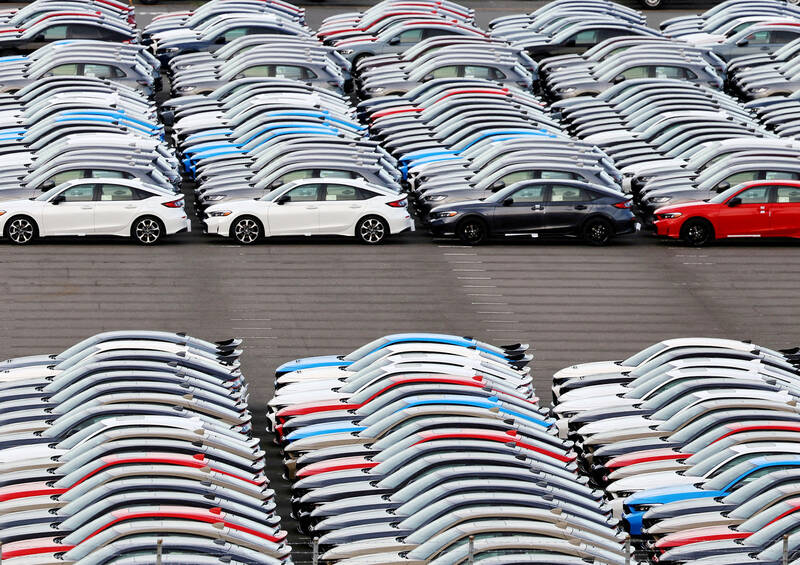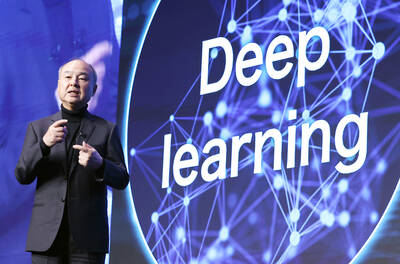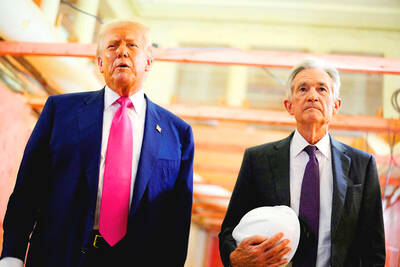The US has confirmed it would end stacking of universal tariffs on Japan and cut car levies as promised, Japan’s top trade negotiator Ryosei Akazawa said after a meeting on Thursday with his counterparts in Washington.
His comments following talks with US Secretary of Commerce Howard Lutnick and US Secretary of the Treasury Scott Bessent provided some relief amid doubts over the details of the trade deal reached between the two nations last month.
The US officials expressed regret that the stacking rule had been applied to Japan despite a verbal agreement and said Washington would refund any overpaid levies, he said.

Photo: Reuters
No time frame was agreed for the implementation, Akazawa said after the meetings.
There has so far been no official comment on the latest meetings from the US side.
Japan was hit with higher-than-expected universal tariffs as part of the wave of new levies introduced on Thursday. While the scale of the discrepancy was likely minor, the confusion sparked renewed criticism of Japanese Prime Minister Shigeru Ishiba, who already faces calls to step down over a poor election showing.
“We have confirmed that when the US side takes measures to revise the executive order on universal tariffs, they will issue another order to reduce tariffs on cars and auto parts,” Akazawa said.
“We will continue to urge the US side, through all available means and channels” to make those things happen, he said.
He added that he was not sure when the orders would be issued, but he did not expect it to take as long as six months or a year.
Under the stacking system, the 15 percent tariff applied to Japan is being added to existing levies on its products. When Japan receives an exemption, Akazawa said that the 15 percent rate would apply to items that previously had levies of less than 15 percent, while items that in the past had tariffs of more than 15 percent would no longer face additional levies.
More importantly for the Japanese economy, automakers are still struggling with tariffs at 27.5 percent — a combination of a previous 2.5 percent rate and a new 25 percent levy.
“With each day that passes, the losses incurred by Japanese companies are mounting,” Akazawa said, adding that some companies are seeing an hourly loss of ¥100 million (US$678,493), without citing which companies they are.
“In this respect, there is no change to what we have been saying previously. We are seeking the issuance of the executive order as quickly as possible — whether by a day or even by a moment,” he said.
The lack of clarity on the timing of a promised cut to 15 percent is making it hard for the companies, mainstays of the economy, to plan ahead. The auto sector employs about 8 percent of the nation’s workforce and is a trendsetter for wage growth, which has supported the central bank’s gradual interest rate hikes.
The US administration has come under fire from the US car industry over the levies agreed with Japan, which critics say fail to address the biggest source of the US trade deficit with its Asian ally. About 80 percent of the trade gap was due to cars and car parts last year.

IN THE AIR: While most companies said they were committed to North American operations, some added that production and costs would depend on the outcome of a US trade probe Leading local contract electronics makers Wistron Corp (緯創), Quanta Computer Inc (廣達), Inventec Corp (英業達) and Compal Electronics Inc (仁寶) are to maintain their North American expansion plans, despite Washington’s 20 percent tariff on Taiwanese goods. Wistron said it has long maintained a presence in the US, while distributing production across Taiwan, North America, Southeast Asia and Europe. The company is in talks with customers to align capacity with their site preferences, a company official told the Taipei Times by telephone on Friday. The company is still in talks with clients over who would bear the tariff costs, with the outcome pending further

NEGOTIATIONS: Semiconductors play an outsized role in Taiwan’s industrial and economic development and are a major driver of the Taiwan-US trade imbalance With US President Donald Trump threatening to impose tariffs on semiconductors, Taiwan is expected to face a significant challenge, as information and communications technology (ICT) products account for more than 70 percent of its exports to the US, Chung-Hua Institution for Economic Research (CIER, 中華經濟研究院) president Lien Hsien-ming (連賢明) said on Friday. Compared with other countries, semiconductors play a disproportionately large role in Taiwan’s industrial and economic development, Lien said. As the sixth-largest contributor to the US trade deficit, Taiwan recorded a US$73.9 billion trade surplus with the US last year — up from US$47.8 billion in 2023 — driven by strong

AI: Softbank’s stake increases in Nvidia and TSMC reflect Masayoshi Son’s effort to gain a foothold in key nodes of the AI value chain, from chip design to data infrastructure Softbank Group Corp is building up stakes in Nvidia Corp and Taiwan Semiconductor Manufacturing Co (TSMC, 台積電), the latest reflection of founder Masayoshi Son’s focus on the tools and hardware underpinning artificial intelligence (AI). The Japanese technology investor raised its stake in Nvidia to about US$3 billion by the end of March, up from US$1 billion in the prior quarter, regulatory filings showed. It bought about US$330 million worth of TSMC shares and US$170 million in Oracle Corp, they showed. Softbank’s signature Vision Fund has also monetized almost US$2 billion of public and private assets in the first half of this year,

POWELL SUCCESSOR: US Fed Governor Adriana Kugler’s resignation gives Donald Trump an opening on the board, potentially accelerating his decision on the next chair US President Donald Trump suddenly has a chance to fill an opening at the US Federal Reserve earlier than expected, after Fed Governor Adriana Kugler announced her resignation on Friday. It might also force him to pick the next Fed chair months sooner than he had anticipated. “The ball is now in Trump’s court,” LH Meyer/Monetary Policy Analytics Inc economist Derek Tang said. “Trump is the one who’s been putting pressure on the Fed to do this and that, and Trump says he wants to have his own people on. So now he has the opportunity.” Kugler’s exit unfolds amid unprecedented public pressure